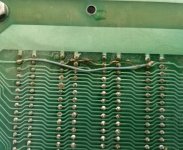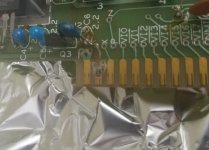Eudimorphodon
Veteran Member
Spent the better part of two hours scrubbing ancient flux off the motherboard, that was loads of fun. Although I know tap water isn't ideal I ended up having no choice but to include a session of scrubbing the board with the toothbrush under running water because I liberated so much flux residue with the combination of IPA and vinegar that although the board would *look* okay after a quick distilled water rinse as soon as it'd start drying out the entire board would crust over with a fuzzy tan deposit. Trickling IPA over the board would result in brown drips off the side, but it wouldn't rinse off enough to make a difference so, yeah, had to hit it with the alcohol and then actively scrub it off under running water. It's *almost* clean now, at least the non-component side. (There's still some patches of residual chalkiness I'll hit after I can buy *another* jug of distilled water for the final rinse.)
There's a blasted trace on the board between slot 12 and slot 9, I think it's on pin 52, the -16v line. (Which I keep erroneously calling 18 volts, apparently.) Curious how that happened. Whoever fixed it just bridged slot 12 to 9, skipping 11 and 10.

There's a blasted trace on the board between slot 12 and slot 9, I think it's on pin 52, the -16v line. (Which I keep erroneously calling 18 volts, apparently.) Curious how that happened. Whoever fixed it just bridged slot 12 to 9, skipping 11 and 10.



